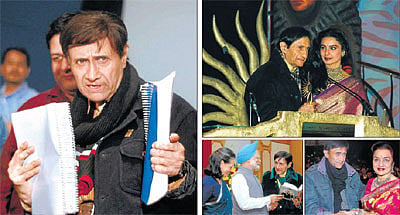
Filmmaker and actor Dev Anand, who breathed his last on Sunday in London, will always be remembered for introducing urban, angst-ridden characters in Indian cinema.
Dev Anand migrated to Bombay (now Mumbai) from his native place, Narowal district in Pakistan, in 1940, after graduating in English literature from Lahore University. He then joined the Indian People’s Theatre at his elder brother and acclaimed neo-realist film maker Chetan Anand’s behest.
Indian cinema in the 50s can be broadly classified into four genres- neo-realist films with socialist strains bursting through every scene, regressive films bleating conservative values, slap-stick comedy aping the West and films depicting the urban underbelly with graphic descriptions akin to the kitchen-sink, angry generation literature.
Dev Anand, without resorting to a designer stubble or raving and ranting, carved a niche for himself, as a figure from the shadowy world of crime and marginal society. Unlike his contemporaries like Raj Kapoor, who, under the spell of Charlie Chaplin, glamourised the vagabond warbling neo-socialistic songs or Dilip Kumar portraying the protagonist in a fading feudal structure through defeatist characters, Dev Anand’s roles mostly focused on urban psychology.
The characters he portrayed did not trace their roots to crumbling feudal mansions, nor were they epicure ‘bhodroloks.’ Possibly an outcome of the greasy world encompassing the mushrooming urban societies in the post-1947 India, the characters which Dev Anand made his forte in the late 50s- despite characterising them with a marked gait and mannerism, each character had a strange attraction towards the grotesque.
The changes that were taking place with the fulmination of urbanisation in the 50s had a marked effect on commercial cinema. The dichotomy of the two worlds in which Indians were trapped was most acutely portrayed by Dev Anand.
Most of the roles he played resembled legendary fictional characters strutting through the wreckages of the society, like Erle Stanley Gardner’s criminal lawyer Perry Mason or Raymond Chandler’s legendary cynical, philosophical detective Philip Marlowe.
Dev Anand, with his artistic sensitivity, always made the character seek respite, not in the fragile and brittle human relationships, but in Proustian moments punctuated with soulful music. In the 60s, his younger brother Vijay Anand took over the director’s baton at Nav Ketan. The result was one of the finest films in the history of Hindi cinema, an adaptation of R K Naryanan’s novel, Guide. The film made Dev Anand’s critics eat crow.
While the 60s saw him feature in several cult films, the 70s brought him to direction. Even accepting assignments for other production houses, Dev Anand’s narcissism started took precedence over his earlier “love for ideas.” Beginning in the 90s the 90s and then on, his films were marked by eccentricity and issues much ahead of times.
